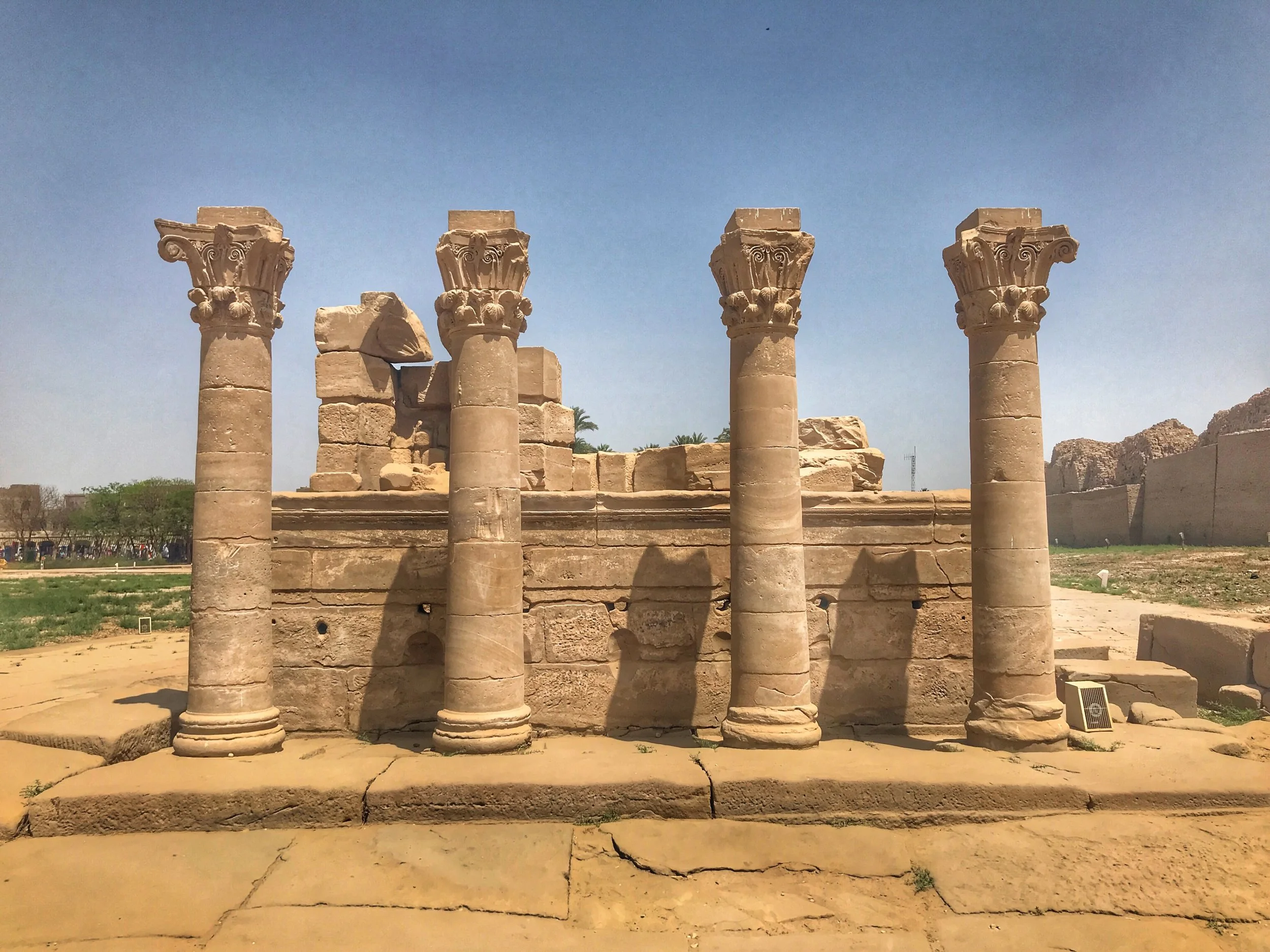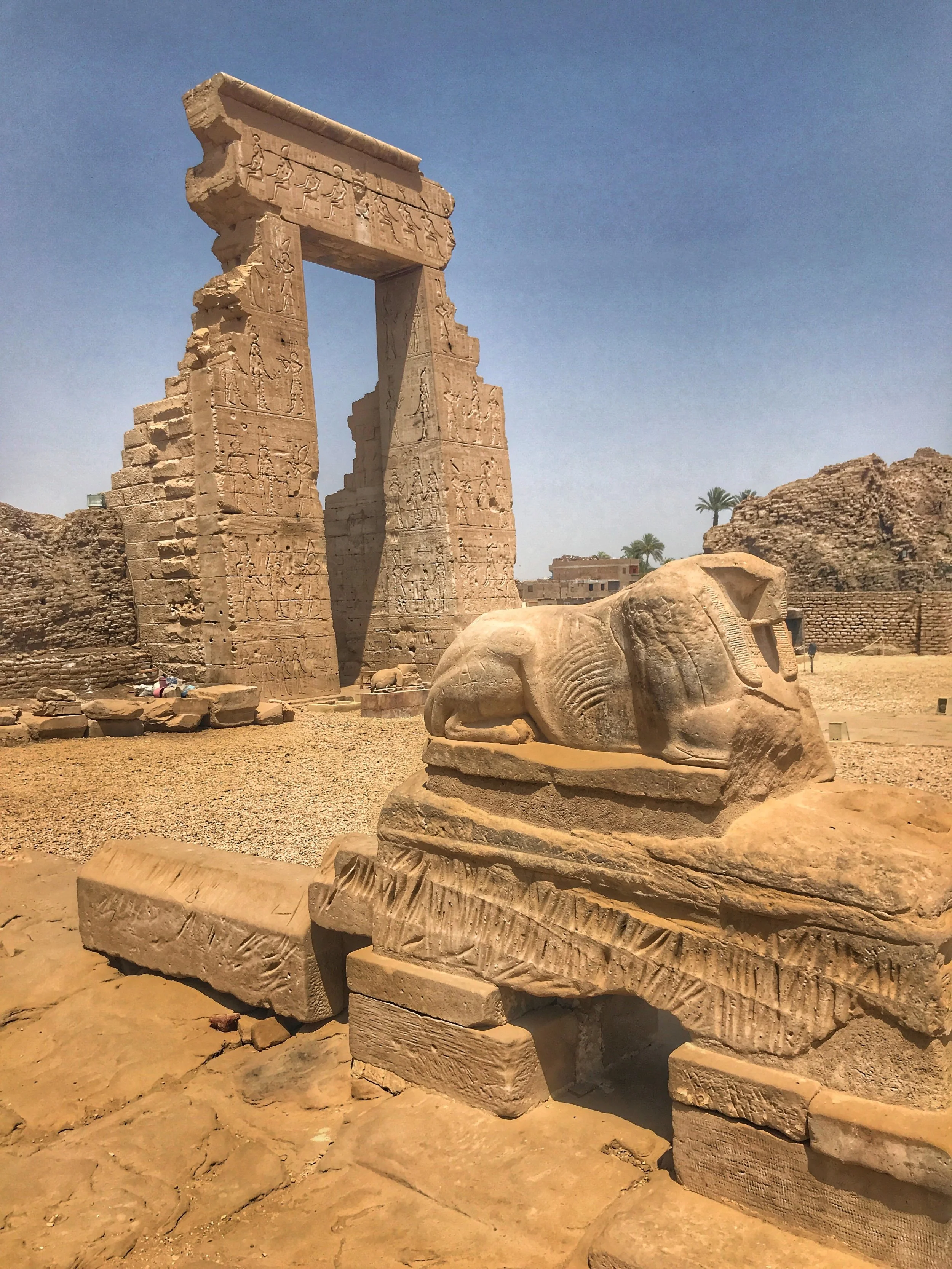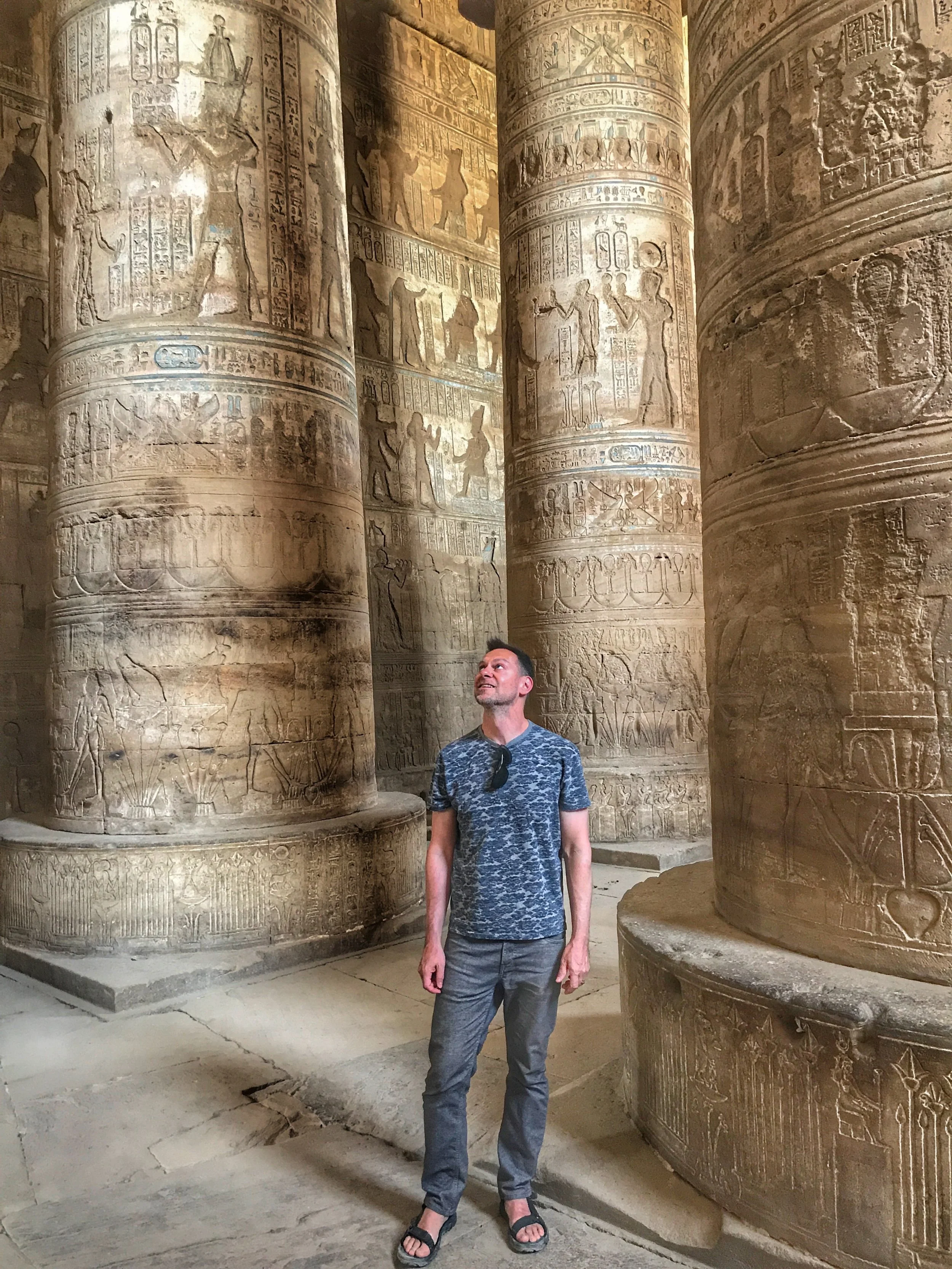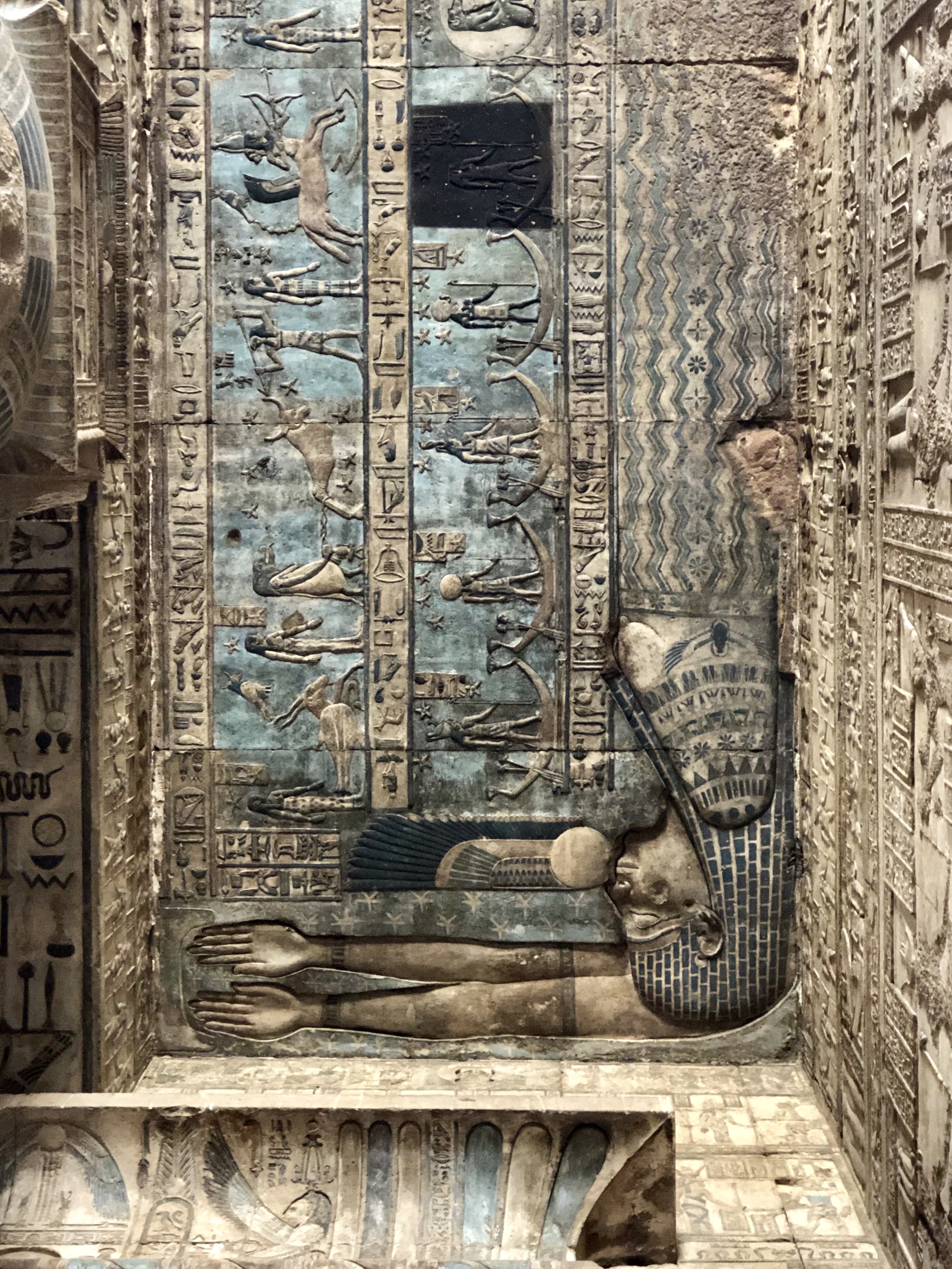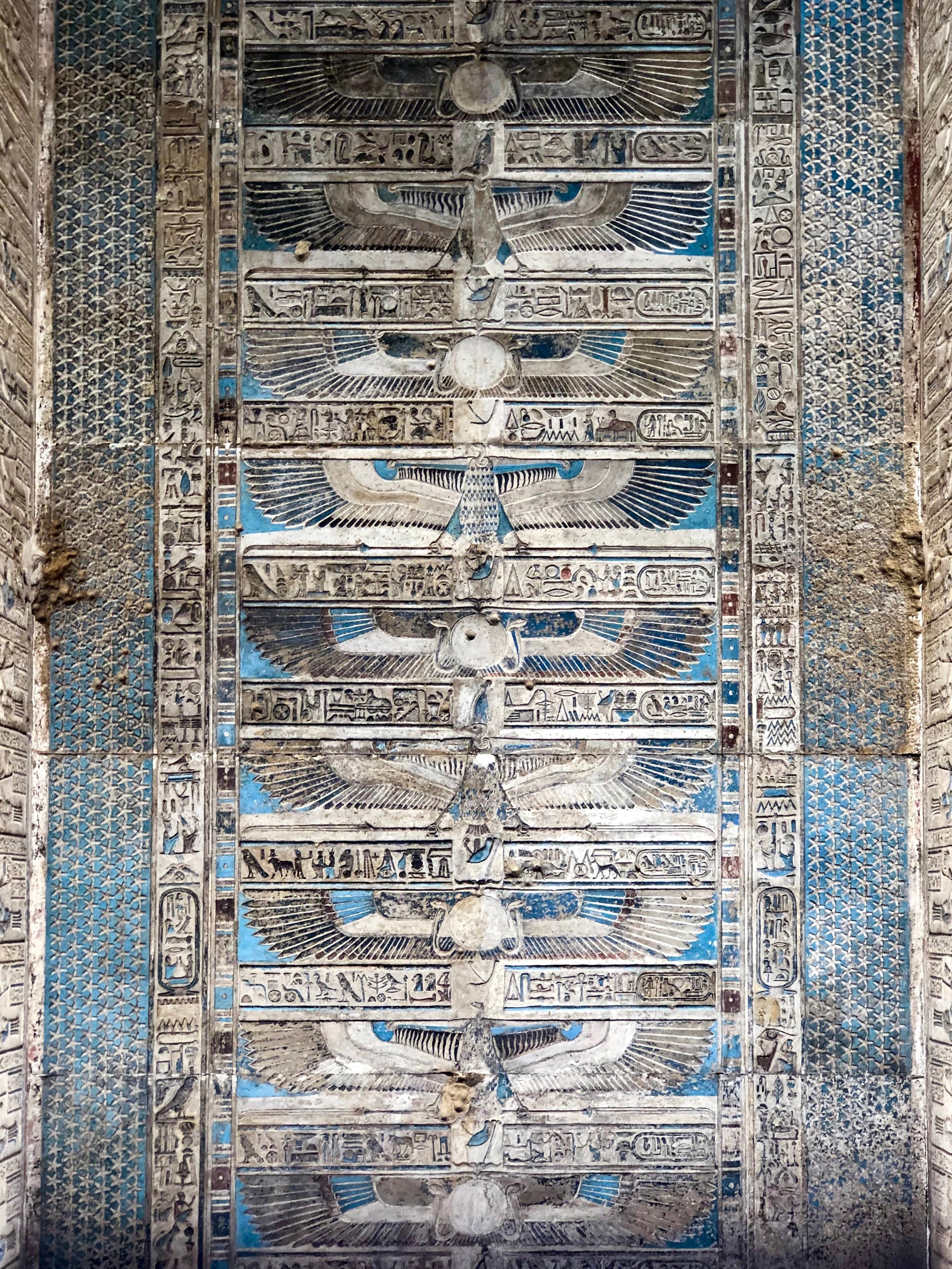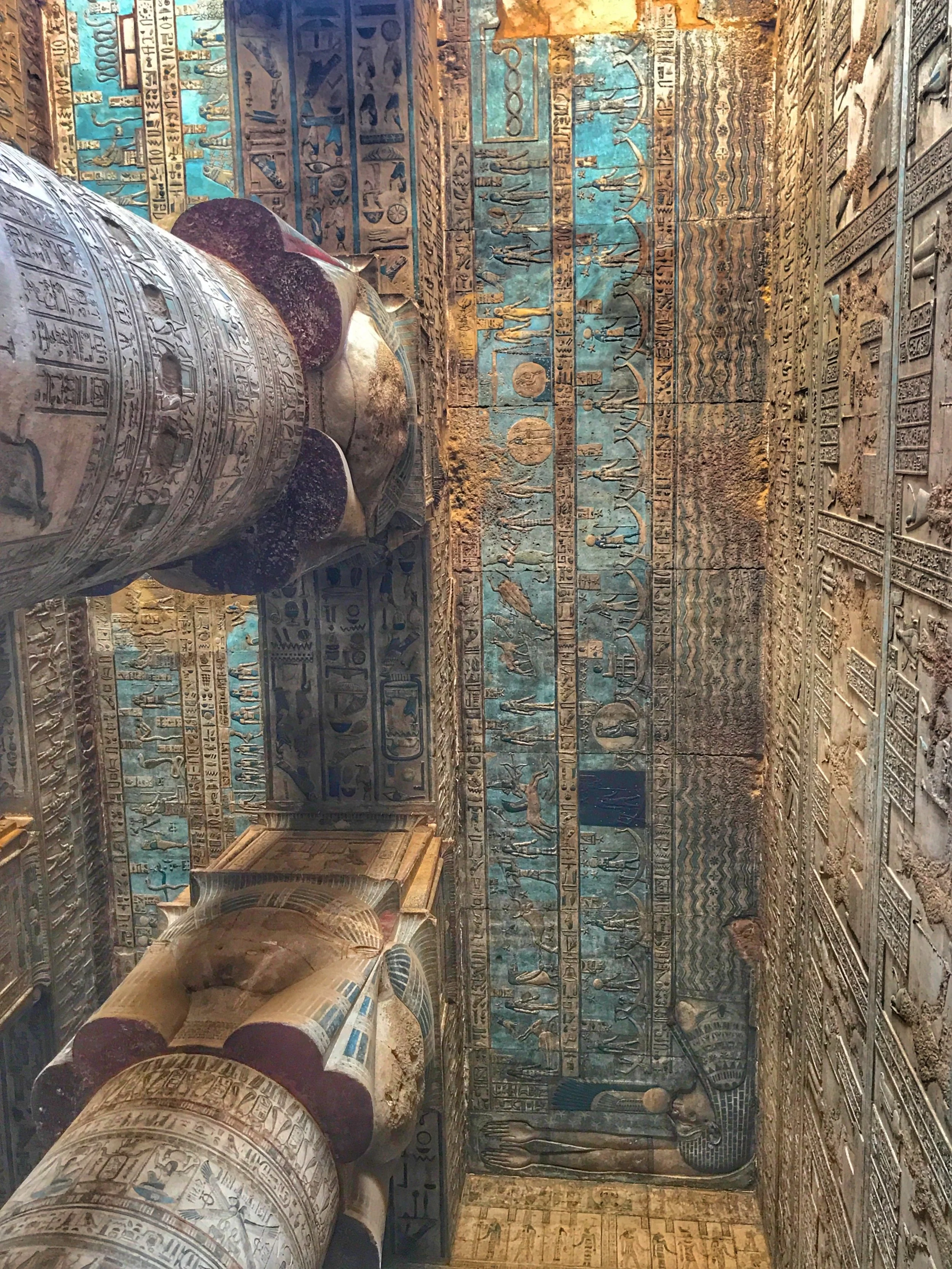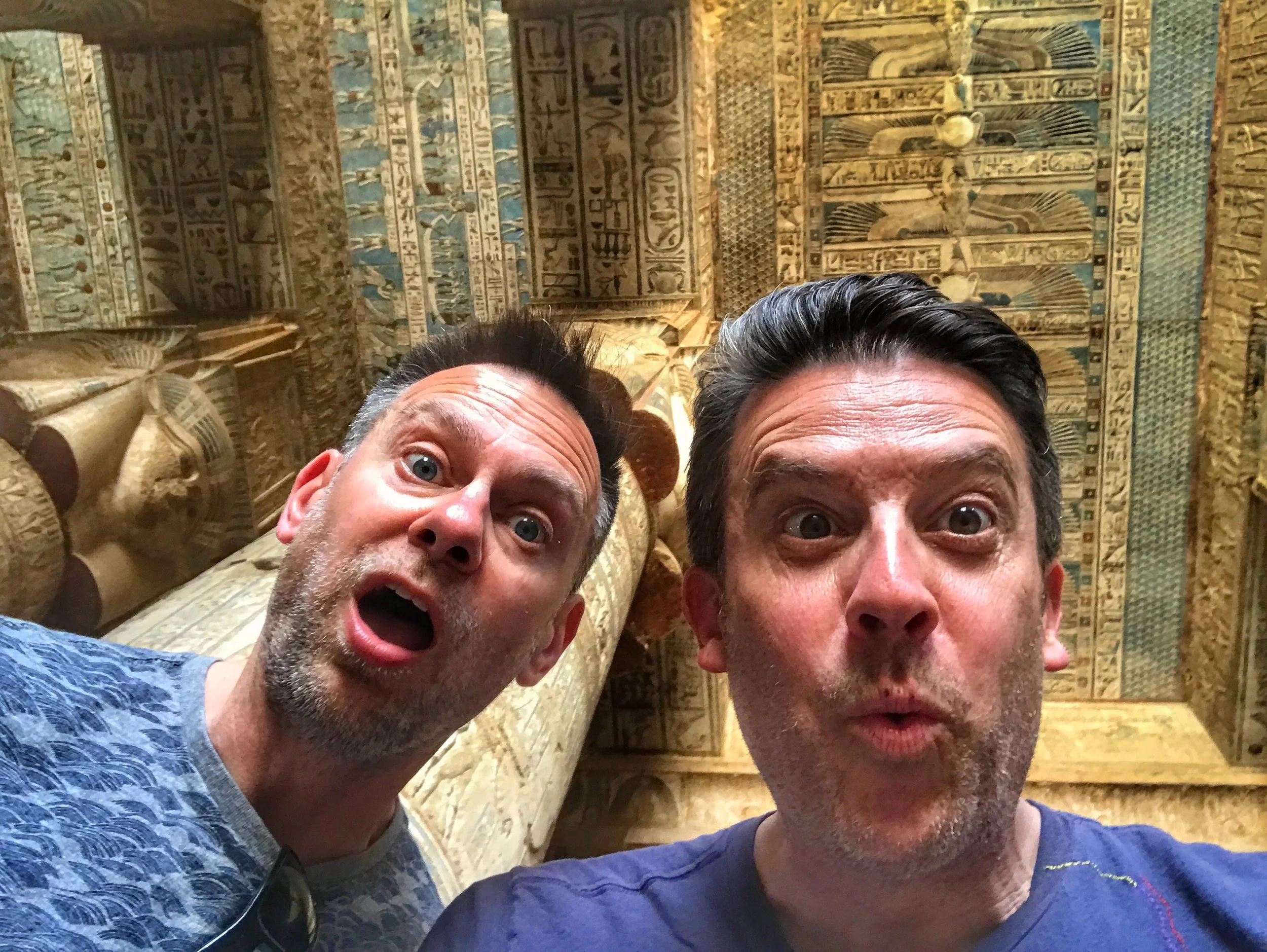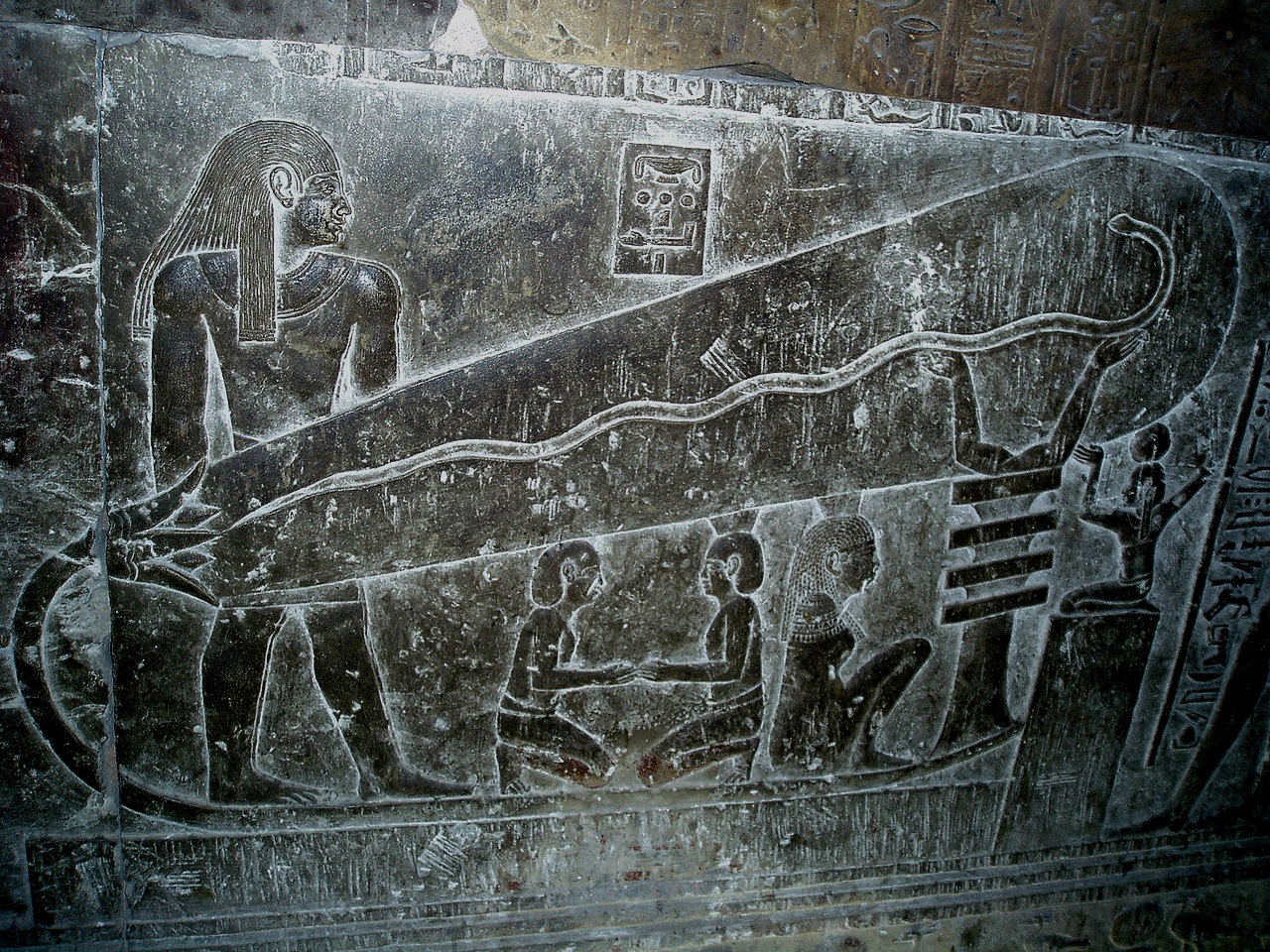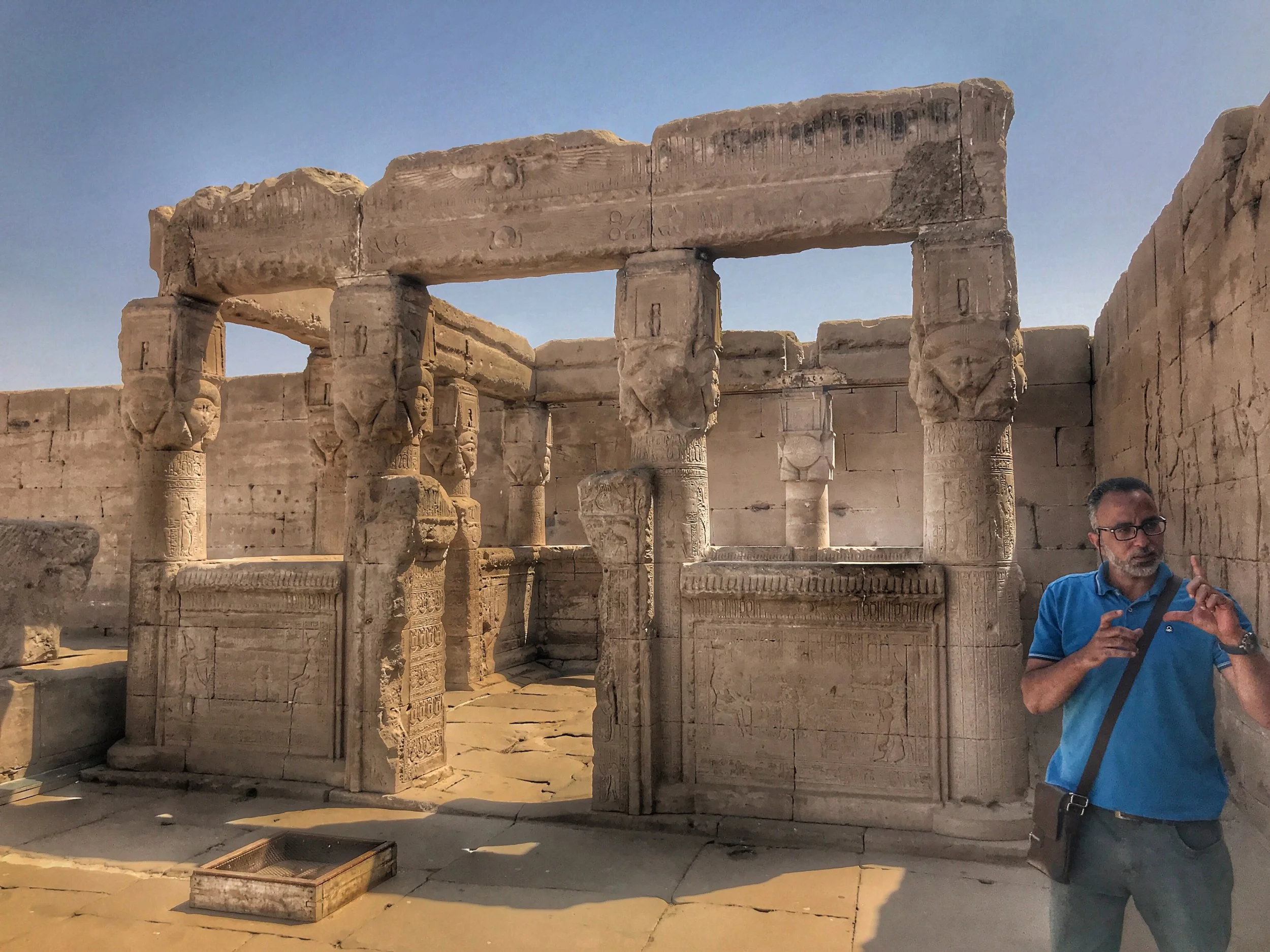Walk up to see the Dendera Zodiac and descend into a secret passage to see the Dendera light bulb.
Dendera’s Temple of Hathor has stood for 2,000 years
A mammisi, or birth house, honored the birth of a god or goddess
This headless sphinx would have been part of a long line of identical statues
Egypt has a storied history, filled with monuments and temples that are all amazing in their own way. But some were much more astonishing than others — and Dendera (also spelled Dandarah) just might be my favorite of the bunch. Its massive columns covered in hieroglyphics utterly dwarf you, and zodialogical creatures romp on the turquoise ceiling. Then there’s the secret passage below the temple.
All of these aspects make Dendera majestic, but there’s something else to it. Duke and I quickly realized that the temples we liked best were those not swarming with tourists. Yes, Abu Simbel is jaw-droppingly awesome, but while visiting there, I felt like a tourist. At Dendera, which we had mostly to ourselves, wandering the quiet, cool colonnade, looking up in awe, I felt like a pilgrim. I truly understood that this was a holy site, a sacred space.
The site includes a couple of birth houses, a large temple, smaller chapels and a pylon gateway
The Dendera Complex
The oldest structure at Dendera is the mammisi of Nectanebo II, the last of the native pharaohs, from 360-343 BCE. Mammisis are translated as “birth houses” and were small chapels at the entrance of temples to honor the nativity of a deity.
Another mammisi stands on the Dendera grounds. It’s generally thought that Nero (Roman emperor from 54-68 CE) began construction, which was then completed by Trajan (who reigned from 98-117 CE), as both are represented in carvings here.
The exterior of the Temple of Hathor glows in the bright sunlight
The temple, originally known as Iunet, or Tentyris in Greek, was commissioned by Ptolemy XII. The Greek ruler set about building temples all over Egypt — not only to win the favor of the natives, who would appreciate a foreign king honoring their time-honored traditions, but also to reap the financial benefits. Temples were landowners, storehouses and centers of economic activity. Queen Cleopatra VII (yes, that Cleopatra) wrapped up construction. She had bas-reliefs carved of her and Caesarion, her son by Julius Caesar. Construction took place around 54-20 BCE.
How cool is it to think that you’re walking around a temple that Cleopatra herself helped build and worshipped in?
It’s sad to see that every single image of Hathor atop the columns has been vandalized
The Much-Loved, Multifaceted Hathor
Hathor was one of the most popular goddesses in the Egyptian pantheon, her roles shifting through the ages. Her hieroglyphics literally translate to “House of Horus,” referring to her protective role as a mother figure and/or wife of the falcon god Horus. As such, she was also a sky goddess, ruling over the realm where Horus flew.
You’ll often see Hathor bearing a cow head or just the ears, as depicted atop Hathor columns like those at Dendera. This refers to her role as a nurturing royal nurse; she’s said to suckle the pharaohs of Egypt — even as adults.
A rare non-mutilated top of a Hathor column at the site. Check out Hathor’s cute little cow ears
She was also called Mistress of the Vagina and was associated with fertility and female sexuality. (No surprise that the Greeks connected her with Aphrodite.)
And, among other attributes, Hathor was the goddess of drunkenness and music. A rattle-like instrument called a sistrum was used in her worship.
Hathor’s dominions are pretty all-encompassing and were tied to the monarchy. Her worship took place all over Egypt — but it was centered at Dendera.
Hathor, seen at the top of these columns, was a popular goddess, her domains covering everything from motherhood to sexuality, from healing to drunkenness
The highlight of the year for the worship of Hathor was the festival of her marriage to Horus. During the summer, her sacred statue would travel by boat along the Nile to the Temple of Horus at Edfu. There it would unite with that of Horus, and a raucous celebration would take place over the next two weeks.
Duke admires the giant scale of the temple
Exploring the Temple of Hathor
The Temple of Hathor remains — in fact, with Philae, it’s one of the best-preserved temples of the Greco-Roman period in Egypt. Temples to her consort Horus and their child, Ihy or Harsomptus, once stood nearby but have been destroyed.
Policemen and guards in robes are common sights at Egypt’s temples
Egyptian pharaohs and Roman emperors played their part in the construction of Dendera over the centuries
The walls and columns of Dendera’s Temple of Hathor are covered with carvings
The massive colonnade is what really makes Dendera a marvel to explore
Imagine the temple as it originally stood — gleaming white in the desert sun, the carvings that cover the façade painted in bright colors. Now, though, thousands of years of sand and wind erosion have reduced the exterior to the same color as the sand it stands upon.
The gateway in front was constructed during the reigns of the Roman emperors Domitian and Trajan, and fit within the surrounding mud-brick wall that enclosed the complex.
During the 1st century, Emperor Tiberius added the gorgeous hypostyle hall, featuring 24 soaring columns bearing the cow-eared head of Hathor, each face vandalized in antiquity. The ceiling retains its original paint, and you’ll get a sore neck craning to look up at it — but it’s worth it. After the empire fell, the temple was half-buried in sand, and locals used the structure as shelter, lighting fires for cooking and warmth. There are still swaths of the ceiling that remain covered in soot, but the scenes that have been revealed after meticulous restoration are nothing short of incredible.
The sky goddess Nut frames this part of the ceiling, swallowing the sun at twilight and giving birth to it in the morning. You can also see signs of the zodiac, including Taurus the Bull and Sagittarius the Archer
It features a chart of the heavens, including signs of the zodiac, which the Romans introduced. You’ll also see the goddess Nut in her typical position: straight-armed and straight-legged, forming three sides of a square to represent the sky. Every evening she swallows the sun, which then passes through her body, until she gives birth to it the next day at dawn.
You’ll see this vulture motif on a lot of temple ceilings — it depicts Nekhbet, the protector of Upper Egypt (in the south part of the country) and the pharaoh. The serpents are a reference to Wadjet, goddess of Lower Egypt. Together, they show the unification of the realm
Crane your neck to look up at Dendera — the blue ceiling is one of the coolest parts of this temple
Duke and Wally kept oohing and ahhing at Dendera
The inner hypostyle hall is where the statue of the goddess Hathor and her solar barque would be brought from her sanctuary during festivals.
Inside the sanctuary, there’s a false door, usually built to allow the soul’s passage in and out of the underworld. This one is unusual in that it’s high up. You can climb a ladder into this loft, where the statue of Hathor was usually kept.
A lot of carvings in Ancient Egyptian temples show pharaohs making offerings to the various gods
Around back of the sanctuary, a passage slopes down to a sunken chamber. our guide Mamduh (pronounced Mom-doo) explained that due to a marvel of acoustics, supplicants could whisper prayers to the goddess, and her priestess could respond mysteriously from below.
The Dendera Light Bulb From Ancient Aliens
Secret passageways lead to subterranean crypts, where treasure was hidden away. Duke and I of course opted to take the makeshift ladder down and squeeze into the narrow space to explore them. The walls are covered with the most bizarre hieroglyphics we have seen on this trip. We were down there with another couple from the United States, and as we headed back up, we heard the man excitedly call out, “It’s the lightbulb from Ancient Aliens!”
Wally and Duke crept down into this secret passageway, where treasures were once hidden away. It’s now more famous as housing “the Dendera light bulb” carving
He was referring to a strange carving of long, tapering ovals with squiggles inside. The crackpot TV show Ancient Aliens insists that this represents a light bulb, 4,000 years before Thomas Edison “invented” it. How did the Ancient Egyptians have electricity to light the temple? Why, alien technology, of course.
Here it is: the legendary Dendera light bulb. Is it a depiction of the creation of the world — or evidence that aliens shared their technology with Ancient Egyptians?
When we met up with our guide Mamduh and told him what we had heard, he smiled and nodded, familiar with that particular conspiracy theory. He told us that those bas-reliefs were actually how Ancient Egyptians depicted the moment of creation; the “light bulb” is actually a representation of the womb of the goddess Nut, and the so-called filament inside the bulb is obviously a snake.
Book your tours of Egyptian temples with EGYPT SUNSET TOURS.
The oldest complete sky map of the ancient world, the famous Dendera Zodiac, now in Paris’ Louvre museum
The Chapel of Osiris and Dendera Zodiac
After descending into the secret passageway, we took a corridor up to the top of the temple. It spiraled up gradually as a tribute to the falcon-headed god Horus, mimicking the circling pattern of the birds of prey when rising into the sky. (Another staircase for descent is short and straight, like the plunging dive a falcon takes when attacking prey.)
Our guide Mamduh explains how the statue of the goddess Hathor was brought to the solar chapel to rejuvenate in the sunshine
At the top of the structure is a small temple that was used for rituals to greet the rising sun.
There’s also the Chapel of Osiris, a small dark room, depicting the death and resurrection of the god.
The Osiris Chapel shows scenes of the god’s death and resurrection
The portico at the entrance features a blackened ceiling relief known as the Dendera Zodiac. It’s said to be the only complete map we have of an ancient sky. Most of the zodiac representations are the same as today, though Aquarius is shown as the Nile god Hapy.
Mamduh explained that the one we were looking at was actually a replica. In 1821, the Egyptian ruler, Mohamed Ali Pasha, allowed the original to be transported to Paris, France, where it remains, on display at the Louvre.
The ruins of a sanatorium are also on the grounds, for Hathor, that goddess of all trades, was also a healer. Pilgrims would come here to bathe in the sacred pool and bring home containers of holy water. There were also sleeping quarters here where supplicants would hope to dream of the goddess and receive her wisdom.
Admission to the temple costs 100 Egyptian pounds. Even without the secret passage that has launched a thousand conspiracy theories, the aqua blue ceiling covered with zodialogical signs and massive columns in the Temple of Hathor make Dendera a must-see. It’s an hour-and-a-half drive from Luxor and can be paired with Abydos. –Wally
Dendera Temple Complex
Qism Qena
Dandarah
Qena Governorate
Egypt


